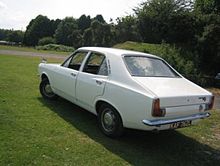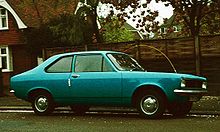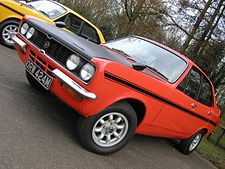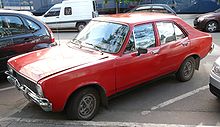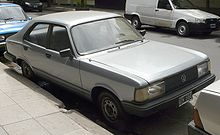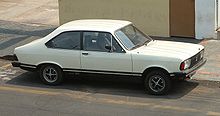- Hillman Avenger
-
For the pre-1964 Sunbeam-Talbot or Sunbeam-Talbot-Darracq cars, see Sunbeam (car company)#Post-war.
Hillman Avenger 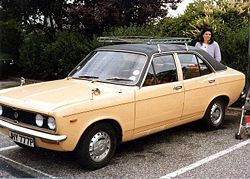
Manufacturer Rootes Group
Chrysler EuropeAlso called Chrysler Avenger
Talbot Avenger
Sunbeam Avenger (Europe)
Dodge Avenger (South Africa)
Plymouth Cricket (U.S/Canada)
Dodge 1800 (Brazil)
Dodge Polara (Brazil)
Dodge 1500 Pickup (Uruguay)
Dodge 1500 (Argentina)
Volkswagen 1500 (Argentina)Production 1970–1981
Argentina until 1988Predecessor Hillman Minx Body style 4-door saloon
5-door estate from 1972
2-door saloon from 1973Layout Front-engine, Rear-wheel drive Engine 1248 cc I4 (1970–1973)
1295 cc I4 (1973–1981)
1498 cc I4
1598 cc I4 (1973–1981)
1798 cc I4 (South America)Transmission 4-speed manual
3-speed automaticWheelbase 98 in (2,500 mm) Length 161 in (4,100 mm) Width 62 in (1,600 mm) Height 53 in (1,300 mm) The Hillman Avenger was a rear-wheel drive small family car originally manufactured under the Hillman marque by the Rootes Group from 1970–1976, and made by Chrysler Europe from 1976–1981 as the Chrysler Avenger and finally the Talbot Avenger. The Avenger was exported to North America and sold there as the Plymouth Cricket.
The Avenger was initially produced at Rootes' plant in Ryton-on-Dunsmore, England, and later at the company's Linwood facility near Glasgow, Scotland.
1970: Hillman Avenger
Introduced in February 1970, the Avenger was significant as it was the first and last car to be developed by Rootes after the Chrysler takeover in 1967. Stylistically, the Avenger was undoubtedly very much in tune with its time; the American-influenced "Coke Bottle" waistline and semi-fastback rear-end being a contemporary styling cue. However, from an engineering prospective it was rather conventional, using a 4-cylinder all-iron overhead valve engine in 1250 or 1500 capacities driving a coil spring suspended live axle at the rear wheels. Unlike any previous Rootes design, there were no "badge-engineered" Humber or Singer versions in the UK market. The Avenger was immediately highly praised by the press for its good handling characteristics and generally good overall competence on the road and it was considered a significantly better car to drive than rivals like the Morris Marina.
Initially, the Avenger was available as a four-door saloon in DL, Super and GL trim levels. The DL and Super could be had with either the 1250 or 1500cc engines but the GL was only available with the 1500 cc engine. Since the DL was the basic model in the range, it featured little more than rubber mats and a very simple dashboard with a strip style speedometer. The Super was a bit better equipped, featuring carpets, armrests, twin horns and reversing lights, though the dashboard was carried over from the DL. The top-spec GL model featured four round headlights (which was a big improvement over the rectangular ones from the Hillman Minx that were used on the DL and Super), internal bonnet release, two-speed wipers, brushed nylon seat trim (previously never used on British cars), reclining front seats, and a round dial dashboard with extra instrumentation.
Not only was the Avenger's styling totally new, but so were the engine and transmission units, which were not at all like those used in the larger "Arrow" series Hunter. Another novelty for the Avenger was the use of a plastic radiator grille, a first in Britain and at 4 ft 6 in (137 cm) wide claimed as the largest mass-produced plastics component used at this time by the European motor industry.[1] The Avenger was a steady seller in the 1970s, in competition with the Ford Escort and Vauxhall Viva. Chrysler wanted the Avenger to be a "world car", and took the ambitious step of marketing the Avenger as the Plymouth Cricket in the U.S. Complaints of rust, unreliability, plus apathy towards small cars amongst buyers in the U.S., saw it withdrawn from that market after only two years.
Introduction of body & trim variations
In October 1970, the Avenger GT was added to the range. It had a twin-carburettor 1500 cc engine, four-speed manual or three-speed automatic transmission (also optional on the 1500 DL, Super and GL). The GT featured go-faster stripes along the sides of the doors and dustbin lid wheel covers, which were not unlike those found on the various Datsuns and Toyotas of the 1970s.
The basic fleet Avenger was added to the range in February 1972. It was offered with either 1250 or 1500 cc engines (the latter available with the automatic transmission option). The fleet Avenger was very basic: it did not have a sun visor for the front passenger, and the heater blower had just a single speed.[2] In October 1972, the Avenger GT was replaced by the Avenger GLS, which came with a vinyl roof and Rostyle sports wheels.
In March 1972, the five-door estate versions were introduced, in DL and Super forms (both available with either 1250 or 1500 cc engines) and basically the same specifications as the saloon versions. However, 'heavy-duty springing' was fitted and the estate had a maximum load capacity of 1,040 lb (470 kg), compared to 840 lb (380 kg) for the saloon.[2]
The two-door saloon models were added in March 1973, with all engine and trim options of the existing four-door range.[3] Styling of the 2-door was similar to the 4-door, but the side profile was more subdued.
The car was extensively marketed in continental Europe, first as a Sunbeam. It was without the Avenger name in France, where it was known as the Sunbeam 1250 and 1500; later the 1300 and 1600. Some northern European markets received the car as the Sunbeam Avenger.
Both engine sizes were upgraded in October 1973. The 1250 became the 1300, while the 1500 became the 1600, with nearly all the same previous trim levels except for the basic fleet Avenger, which was discontinued at this point. The GL and GT trim levels were now also offered with the 1300 engine and two-door saloon body.
1971–73: Plymouth Cricket for North America
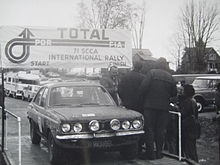 Plymouth Cricket, winner of the 1971 Press-on-Regardless Rally
Plymouth Cricket, winner of the 1971 Press-on-Regardless Rally
In North America, the Avenger was sold as the Plymouth Cricket through Plymouth dealers as a captive import. The car was essentially an example of badge engineering and Plymouth made few changes to it. Only the 4-door saloon and 5-door estate variants were ever offered, due to the 2-door Avenger being unavailable at the time. It had 9.5" front disc brakes and 8" rear drums.[4] Brochures included a cartoon cricket.[5]
A Chrysler Plymouth press release dated 30 June 1970 stated that the Cricket was going to be shown to the automotive press for the first time in November 1970. The first shipment of 280 Crickets from the UK arrived in the U.S. on 20 November 1970. Another press release issued on 23 February 1972 stated that the "station wagon" version was going to début in early spring of 1972.
Differences from the Avenger
The 1500 cc engine was offered on the Plymouth Cricket, the 1250 being a little underpowered for American tastes. Side parking lights were added, and front disc brakes were standardised; these were originally optional in the UK. The single carburettor / manual choke combination was standard. From 1972, the single carburettor / automatic choke combination, dual carburettors, and air conditioning were all options.
Due to American federal laws regarding headlight design, all Cricket models regardless of trim level used the round four headlight grille of the "GL" and "GT" model Avengers.
Demise of the Cricket
The Cricket was discontinued midway through the 1973 model year, despite the gas crisis of 1973 seeing a sharp increase in demand for small cars and despite the fact that Dodge began to see real success with its similarly-sized Dodge Colt, built by Mitsubishi Motors.
The Cricket name lived on in Canada, however, as Chrysler Canada replaced the British-built Cricket with a rebadged Dodge Colt in mid 1973 model year. The Cricket's version of the Colt GT was called the Cricket Formula S. For the 1975 model year, the Plymouth Cricket was rebadged as the Plymouth Colt. Thus began Chrysler Canada's dual marketing system, selling the Colt as both a Dodge and a Plymouth. The later Plymouth Arrow was similarly sold as a Dodge Arrow.
The last British-built Crickets were actually imported into the U.S. in the later part of 1972 but were sold until mid-1973 as "1973" models. This was because U.S. safety and emission laws became effective based on the calendar year the car was manufactured in or imported in, as opposed to the model year. Chrysler used this loophole to continue selling what were essentially 1972 cars through 1973 as 1973 models.
1972: the Avenger Tiger
Named to evoke memories of the Sunbeam Tiger, the Avenger Tiger concept began as a publicity exercise. Avenger Super 4-door cars were modified by the Chrysler Competitions Centre under Des O' Dell and the Tiger model was launched in March 1972. Modifications included the 1500 GT engine with an improved cylinder head with enlarged valves, twin Dell'Orto carburettors and a compression ratio of 9.4:1. The engine now developed 92.5 bhp (69.0 kW) at 6100 rpm. Suspension is also uprated, whilst brakes, rear axle, and gearbox are from the GT.
A distinctive orange colour scheme (although described as "yellow") with a bonnet bulge, rear panel and side stripes was standard, set off with "Avenger Tiger" lettering on the rear quarters.
Road test figures demonstrated a 0–60 mph time of 8.9 seconds and a top speed of 108 mph (174 km/h). These figures beat the rival Ford Escort Mexico, but fuel consumption was heavy. Even in 1972, the Tiger developed a reputation for its thirst.
All Avenger Tigers were assembled by the Chrysler Competitions Centre and production figures are vague but around 200 of the initial Mark 1 seems likely.
In October 1972, Chrysler unveiled the more "productionised" Mark 2 Tiger. The Avenger GL bodyshell with four round headlights was used. Mechanically identical to the earlier cars, the bonnet bulge was lost although the bonnet turned matt black, and there were changes to wheels and seats. These cars went on at £1350. Production was around 400. Red was now available as well as red, with black detailing.
1976: a re-badge to Chrysler and a facelift
In September 1976, the Avenger was rebadged as a Chrysler. It also gained a comprehensive facelift which included a new frontal treatment and a new dashboard. Both treatments looked similar to those of the Chrysler Alpine. The greatest change was at the rear where, on the saloons, the distinctive "hockey-stick" rear lamp clusters were dropped in favour of a straight "light-bar" arrangement. The top of the former "hockey-sticks" had body-coloured metal in their place, whilst the fuel cap was moved from the rear to the right hand side of the car.
Three trim levels were available, LS, GL (known as 'Super' in certain markets) and GLS—the GLS being only available in a high-compression 1.6 L form.
1979: Talbotization and the end
Towards the end of the 1970s, the Avenger was being increasingly outclassed by the new generation of modern front-wheel drive hatchbacks such as the Volkswagen Golf, Vauxhall Astra and Fiat Ritmo/Strada, although this was less of a problem following the launch of the Horizon hatchback in late 1977. In 1978, Chrysler Europe went bankrupt and was taken over by Peugeot, which rebranded Chrysler models as Talbots. The Avenger and Sunbeam survived, rebadged once again, although unlike newer Talbot models such as the Horizon, they retained the Chrysler "Pentastar" badge, instead of the Talbot logo featuring a letter "T" inside a circle. Production continued until 1981, when Peugeot closed the Linwood production plant and concentrated all British production at the Ryton plant, which was in use until the end of 2006, by which time it had been making Peugeot cars for 21 years.
Not all was bleak during this time; the Talbot Sunbeam Lotus enjoyed further development and won the World Rally Championship for Talbot in 1981.
International production
Chrysler's operations in various countries around the world also marketed (and in some cases assembled) the car. In South Africa, the car—like the larger Hunter assembled there—used Peugeot engines and was badged as a Dodge rather than a Hillman, while in New Zealand the car, assembled from CKD kits by importer Todd Motors (later Mitsubishi Motors NZ), was available initially in 4-door and, later, 5-door estate forms.
Denmark and Europe
In Denmark, the versions being sold were:
- 1300 (2-door saloon, 4-door saloon, 5-door estate car)
- 1300 GL (2-door saloon, 4-door saloon, 5-door estate car)
- 1600 GL (2-door saloon, 4-door saloon, 5-door estate car)
- 1600 GLS (4-door saloon, 5-door estate car)
- 1600 GT (2-door saloon, 4-door saloon)
These Danish versions had two-door equivalents which were sometimes exported back to the UK, since two-door models were phased out in the UK market in 1979. The Hillman Avenger name was not used, instead the cars were simply badged as Sunbeam and the engine size and trim level (e.g. Sunbeam 1600 GLS).
Throughout most of Europe the Sunbeam name was used, except for the Netherlands, Italy and Spain.
Argentina
The Avenger was built in Argentina between 1971 and 1988, initially as the Dodge 1500 (or Dodge 1500M with the 1.8 engine), in 4 door sedan.
In 1977, the Dodge 1500 GT-100 producing 105 bhp (78 kW) was introduced. It had the 1800 engine, two Stromberg carburettors, a 8.5 in (22 cm) diameter clutch and a high performance manifold. This model could be had only in dark blue or black with obligatory sports stripes. In 1978, the first station wagon (estate version)–Dodge 1500 Rural–were announced.[6]
In 1982, after Volkswagen acquired the tooling from Chrysler when the latter withdrew from South America, it was renamed the Volkswagen 1500 (not to be confused with the totally different Volkswagen Type 3, which was sold elsewhere in the world as a Volkswagen 1500 too).
Under Volkswagen, the car received its final facelift, gaining a sloping front grille which was more in vogue in the early 1980s. This vehicle was very popular with taxi drivers, but by the end of 1998 they had all met the 10-year age rule on Argentine taxi vehicles. A total of 262,668 units were sold in its almost 20-year lifespan.
An Avenger-based pickup truck called the Dodge 1500 Pickup was made in Uruguay, but the conversion failed to properly account for structural rigidity and they literally broke apart.
Complete as a CKD kits from Argentina where also exported to Chrysler Colmotores for assembly in Colombia from 1973–1978.
Brazil
The Avenger was also built in Brazil from 1973–1981 in 2-door sedan form only, sold initially as Dodge 1800, named for its motor—the motor design was the same as found in Avengers sold elsewhere, although enlarged to a 1.8 L capacity. Styling was slightly different to the British built Avengers, notably due to the use of larger bumpers, a 4-headlamp grille (which was different to the design found on 4-headlamp Avengers and the American Plymouth Cricket) and conventional taillights, which did not have the 'hockeystick' shape of the Hillman Avenger.
In 1977, the car was renamed Dodge Polara (a nameplate Chrysler previously used on full-sized Dodge models in the U.S.), and underwent a comprehensive facelift, gaining the Chrysler Avenger's front styling, and dashboard setup—the revised bumpers and taillight treatments remaining unique to Brazil. A further light facelift was given in 1980 before production ceased in 1981.
New Zealand
The Avenger was sold by Todd Motors in New Zealand from 1970–1981 in four-door sedan and five-door wagon (1974 onward) forms only. Todd's of Petone and, later, Porirua also sold Chrysler Australia and Mitsubishi products and their assembly lines both at the original Petone plant (dating from the 1920s) and the new purpose-built plant opened in Porirua in 1975 were notable for the variety of models coming down the twin final assembly lines at any one time—vehicles sharing the trim lines with the Avenger on a daily shift might include the Hillman Hunter, Chrysler Valiant and Alpine hatchback, Mitsubishi Galant, Mirage and Lancer, as well as the Datsun 180B (due to Todd Motors for a time having a contract to build those as Nissan's other contractor at the time, Campbell Motor Industries, did not have enough capacity).
The New Zealand Avenger initially was similar to the British line but there was just one engine and trim level to start: the 'Super' (two headlights, vinyl trim, 1.5 L single carburettor engine, manual 4-speed gearbox.). In 1971 Todd's added a unique-to-NZ, sporty, 1.5-litre twin-carburettor 'TC' model with all-black interior trim, dashtop rev counter, side striping, high-back 'tombstone' front seats, special bright paint colours and new wheel trims, among other detail changes. This was loosely based on the UK GT but lacked that car's 'Rostyle' wheels, using NZ-made, look-alike pressed aluminium wheel trims instead.
The Kiwi TC was effectively replaced in 1973 by the more upmarket Avenger Alpine, another Kiwi special loosely based on the UK 'GL' (four headlights, four-round-dials dashboard instead of a rectangular instrument cluster [though early cars had a blanked-off space instead of the rev counter standardised later], better trim, twin carburettors and vinyl roof), initially with the twin-carburettor 1.5 L engine (changed to a 1.6 L from 1973, later changed again to a single-carb unit and also available for the first time with automatic transmission, the Borg Warner 45 four-speed unit). The Super sedan also gained the 1.6 L engine and auto option in '73 while the range was expanded in 1974 when 1.3 L variants (a result of the fuel crisis that also prompted rival Ford NZ to reintroduce a Cortina 1.3) and 1.6 L manual or automatic 'Super' wagon models were added to the New Zealand assembled range.
Todd's updated its Avenger line in 1977 with the Simca-style front end and dashboard and new tail lights, and added a luxury GLS version, similar to the UK model, in place of the earlier Alpine while the range was rebranded 'Chrysler Avenger'. It again broadly followed the British lineup, albeit with a limited range of models, now consisting of a 1.3GL sedan, a 1.6LS wagon (marketed as 'Avenger Estate') and 1.6 GLS sedans, again with manual or automatic transmissions. The 'base' 1.3 L sedan was a very popular 'entry level' B-category model for rental car company Avis right up to the Avenger's demise in 1981.
An unusual variant unique to New Zealand, available for some years, was a 'van', basically the manual Avenger wagon with a flat rear floor in place of rear seats and fixed, rather than wind-down, rear door windows. This, and rival models, was introduced around 1975 to get around strict post-oil crisis government hire purchase laws in the country that required a 60% deposit for a new car with only 12-month terms versus 25% and three years for a 'light commercial vehicle' which is what these so-called 'vans' were classified as.
Unlike British models, all New Zealand Avengers from 1973 onwards had metric instruments.
Along with the 1971–1979 Vauxhall HC Viva, 1965–1971 FB and FC Victors, and 1976–1981 Vauxhall Chevette ranges, and Austin Allegro, Maxi and Princess, the Avenger was one of several British models to be sold in New Zealand but not Australia. The Avenger was planned initially as a Hillman Hunter replacement for Australia but, due to economics of sourcing, the Japanese Mitsubishi Galant was chosen instead by Chrysler Australia for that market, though it was marketed as the 'Chrysler Galant'. By contrast in New Zealand, the Avenger, Hunter and Mitsubishi Galant (offered from 1972–1977 in coupe form only) co-existed together in Todd Motors' overall lineup, though the Avenger-sized (but much more cramped inside) Mitsubishi Lancer eventually went into local assembly in 1975.
South Africa
The Avenger was assembled and sold in South Africa badged as "Dodge Avenger". To satisfy local content rules a locally-made 1.6 L Peugeot engine, shared with the locally-assembled 404, was used.
Iran
The Avenger was built in Iran from 1978–1980 in 2-door, 69 hp (51 kW) form by Iran Khodro Co. and called Hillman Avenger beside Hillman Hunter (called Peykan).
1977: the Chrysler Sunbeam hatchback
Main article: Chrysler Sunbeam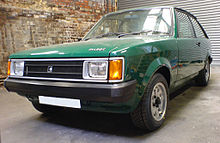 Series 1 Talbot Sunbeam Lotus in an unusual colour scheme; this example started life as an undercover model for Greater Manchester Police. Photo courtesy of Steve Conry, Avenger & Sunbeam Owners Club.
Series 1 Talbot Sunbeam Lotus in an unusual colour scheme; this example started life as an undercover model for Greater Manchester Police. Photo courtesy of Steve Conry, Avenger & Sunbeam Owners Club.
In 1977, a hatchback variant was introduced, known as the Chrysler Sunbeam. This was based on a shortened version of the Avenger's floorplan, and was intended to compete in the lower "supermini" class. It also shared doors with the 2-door Avenger. Initially three engines were available: a 928 cc Hillman Imp-derived unit and 1300 and 1600 Avenger units. A sporty "Ti" version was soon introduced, also with a 1600 engine.
The model's name was a revival of the Rootes Sunbeam marque, which had recently been killed off along with the final Sunbeam model, the Rapier.
In 1979, Chrysler unveiled the Sunbeam Lotus at the Geneva Motor Show. Developed in conjunction with Lotus with rallying in mind (because none of the existing models were competitive) and utilising a 2200 cc Lotus engine, the road-going version of the rally car was not actually ready for deliveries to the public until after the Peugeot buyout (see below), and thus became the Talbot Sunbeam Lotus. At first, these were produced mostly in Lotus' then tobacco-sponsorship colours of black and silver, although later models came in a turquoise and silver scheme.
Sunbeam specifications
Capacity 927–2172 cc Power 42–155 hp (31–116 kW) Max. speed 128–200 km/h (80–120 mph) Acceleration 0–62.5 mp/h: 22.2–8.3 seconds Avenger and Cricket in motorsport
Despite the humble underpinnings, the Avenger was a successful car in motorsport; it was a frequent strong achiever in the British Touring Car Championship owing to the "tuneability" of its engine. The road-going version, the 4-door Avenger Tiger, is now a sought-after classic car.
- In the U.S., driver Scott Harvey was known to have rallied a Plymouth Cricket to win the Press on Regardless Rally of 1971.
- Northern Ireland based Robin Eyre-Maunsell was a works driver for the factory Avenger rally team, run by Des o'Dell, and won the British Group 1 Rally Championship in 1975 and 1976.
- The late Bernard Unett won the British Touring Car Championship using Avengers in 1974, 1976 and 1977.
- Scottish rallydriver Andrew Cowan won the 1976 Heatway Rally of New Zealand in a Hillman Avenger 2-door in 1976, fitted with the expanded 1800 cc Brazilian Dodge 1800/Polara engine.
References
- ^ "Midlands Monitor: What of plastcs?". The Motor: 44. 18 April 1970.
- ^ a b Daily Mail Motor Show Review 1972 on 1973 Cars (London: Associated Newspapers Group Ltd): 24 (Hillman Avenger saloon). October 1972.
- ^ "Avenger Range extended by two-door models". Autocar. 138 (nbr 4006): 48–49. 8 March 1973.
- ^ http://www.oldcarbrochures.com/static/NA/Plymouth/1971%20Plymouth/1971_Plymouth_Cricket_Brochure/1971%20Plymouth%20Cricket-04.html
- ^ http://www.oldcarbrochures.com/static/NA/Plymouth/1971%20Plymouth/1971_Plymouth_Cricket_Brochure/1971%20Plymouth%20Cricket-02.html
- ^ www.rootes-chrysler.co.uk Avenger cars of Argentina|accessdate=24 March 2009
External links
- Help save one of the few Talbot Lotus Sunbeams left in the UK
- The Avenger and Sunbeam Owners Club
- The Sunbeam Lotus Owners Club
- Hillman Avenger Club of Ireland
- Avenger/Cricket/Sunbeam page at Allpar.com
- The Hillman Avenger / Plymouth Cricket web page
- Site for Simca/Chrysler France products
- Avenger web page
- Worldwide Avenger portal
- "What is a Sunbeam Lotus?"
- Brief history, with illustration, of the Sunbeam Lotus
« previous — Plymouth road car timeline, 1970s–2001, United States market Type 1970s 1980s 1990s 2000s 0 1 2 3 4 5 6 7 8 9 0 1 2 3 4 5 6 7 8 9 0 1 2 3 4 5 6 7 8 9 0 1 Subcompact Cricket Horizon TC3 Turismo Colt Colt Colt Colt Compact Arrow Sundance Neon Neon Colt Colt Colt Valiant Volaré Reliant Mid-size Caravelle Acclaim Breeze Satellite Fury Gran Fury Full-size Fury Gran Fury Gran Fury Sports Duster Sapporo Laser Road Runner Road Runner Road Runner Conquest Barracuda Prowler Prowler GTX SUV Trailduster Pickup Arrow Truck Scamp Minivan Voyager/Grand Voyager Voyager/Grand Voyager Voyager/Grand Voyager Van Voyager Categories:- Hillman vehicles
- Rear wheel drive vehicles
- Vehicles introduced in 1970
- 1970s automobiles
Wikimedia Foundation. 2010.


